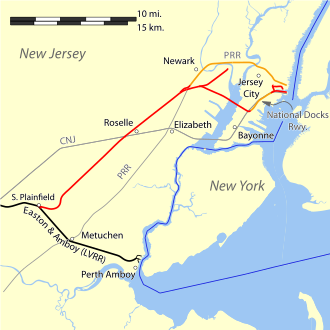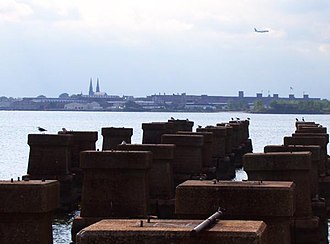Railway accident on Newark Bay
In the railway accident on Newark Bay , New Jersey , on September 15, 1958, the front part of a suburban train fell from a raised lift bridge , the Newark Bay Bridge , into Newark Bay .
Starting position
The suburban train No. 3314 was a first class commuter train of the Central Railroad of New Jersey (CRRNJ) , which was pulled by two diesel locomotives and also consisted of four passenger cars and one baggage car . There were no travelers in the first car .
At around 9 a.m. the train approached the west head of the Newark Bay Bridge . This connected the places Elizabeth and Bayonne , both New Jersey, via Newark Bay. The lift bridge was raised to allow ship traffic to pass. It was secured for railway trains with two distant signals and one main signal , which were about 1200 m, 400 m and 150 m apart in front of the bridge. Immediately behind the last signal was a derailment switch controlled by the signals , which, if the signals blocked passage, was automatically set to “ derail ”.
the accident
The train drove past the two pre-signals and, instead of reducing its speed, it even increased it slightly, as could be seen from the tachograph that was recovered afterwards . He then ran over the main signal showing "Halt" at around 70 km / h. The train then derailed on the derailment switch. Because of its undiminished speed, however, the slip path was not long enough so that the two locomotives and the first two wagons fell into Newark Bay and were immediately sunk. The third car initially got stuck on the edge of the bridge and protruded over it, with the front part of the car already in the water. All travelers were able to escape from this car. He also fell into the bay two hours later.
consequences
44 people in the wrecked wagons and on the locomotives died, including the locomotive crew, the train driver and the front brakeman . 48 people were also injured.
The accident was the subject of three independent investigations: by the Interstate Commerce Commission (ICC), the New Jersey Board of Public Utilities and the United States Army Corps of Engineers .
As the crew also perished on the locomotives, the cause of the accident could never be finally clarified. A sudden health problem of the locomotive driver was suspected. However, the autopsy revealed that the engine driver had drowned , i.e. was still alive, when the locomotive sank. It also remained unexplained why the second man on the locomotive did not intervene. All technical systems were intact, both the train's braking system and the signals.
However, all three investigations came to the conclusion that the lack of a safety drive switch (dead man's button) contributed significantly to the accident. The New Jersey Public Utilities Commission subsequently obliged all railway companies to only use locomotives for passenger trains that were appropriately equipped. The railway company opposed that all locomotives were always manned by two men and that the second man could always perform an emergency brake if the engine driver failed.
The locomotives were salvaged, repaired and put back into service. The bridge was in operation until 1978 and was demolished in 1987/88 because it was an obstacle to shipping.
See also
literature
- Edgar A Haine: Railroad Wrecks . Associated University Presses, 1993, ISBN 0-8453-4844-2 , pp. 134f.
Web links
- Remnants of demolished CRRNJ Newark Bay Bridge, Bayonne New Jersey . Flickr
- Looking Back: 48 killed as train plunges off Newark Bay drawbridge . In: The Star-Ledger , September 15, 2007.
Individual evidence
- ↑ Page no longer available , search in web archives: Interstate Commerce Commission
- ↑ Page no longer available , search in web archives: Interstate Commerce Commission
Coordinates: 40 ° 39 '18.8 " N , 74 ° 9' 50.4" W.

